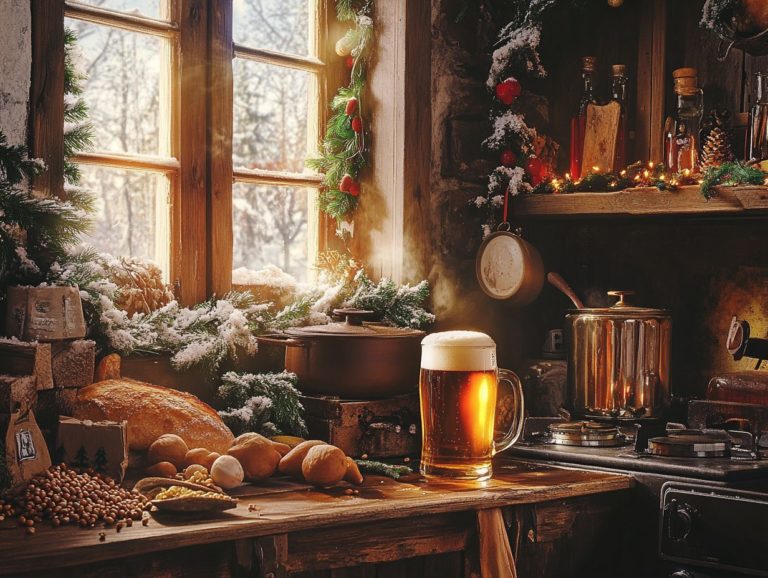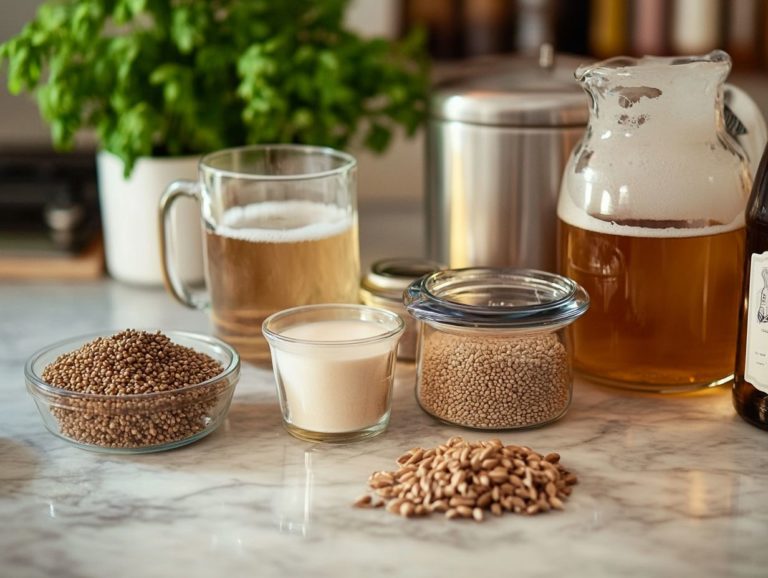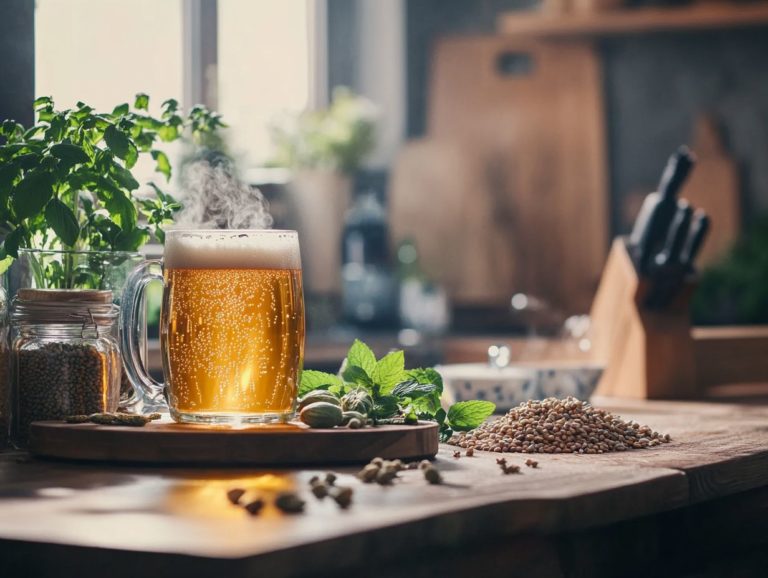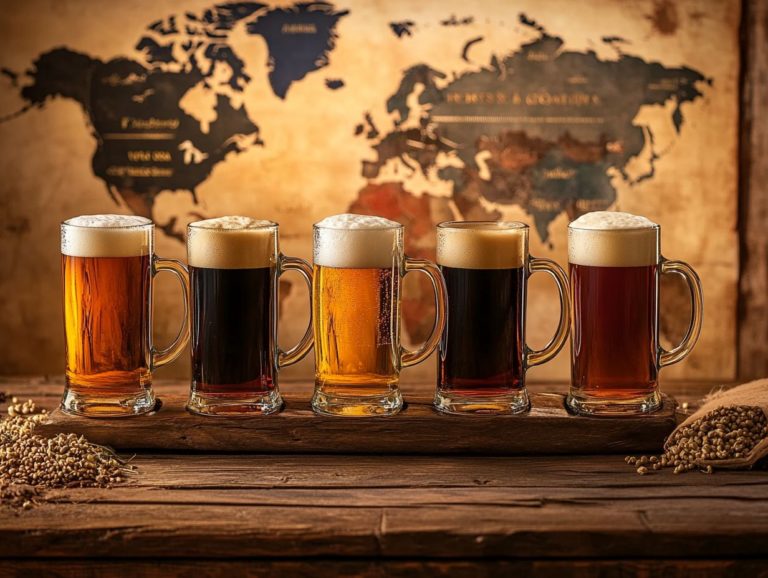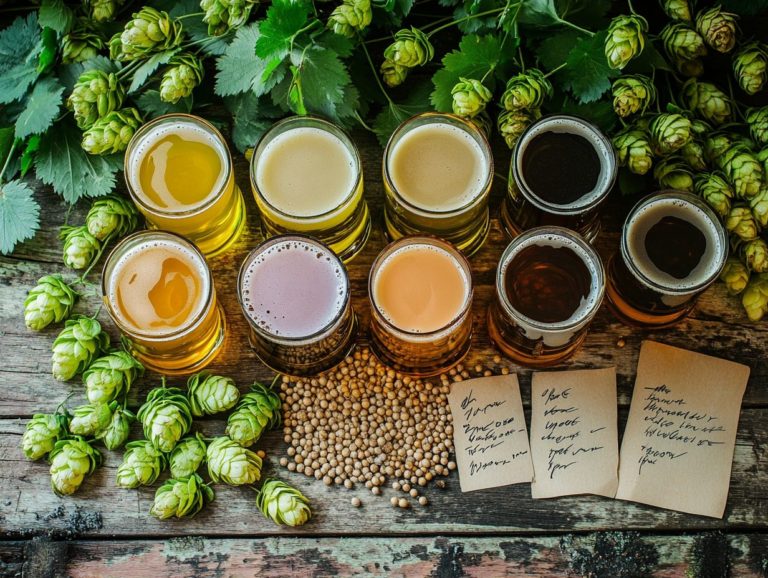How to Develop Your Own Beer Recipe Style
Beer enthusiasts and aspiring brewers will uncover a treasure trove of insights in this comprehensive exploration of beer styles, homebrewing, and recipe development.
By delving into the diverse styles of beer and their unique characteristics, you ll gain a solid foundation for selecting the right ingredients and understanding the brewing process. This guide provides you with the essential tools needed to craft your own exceptional brews and beer recipes.
Learn the art of documenting and refining your recipes, troubleshoot common brewing challenges, and discover how to infuse your creations with distinctive flavors that stand out, using various brewing techniques.
Whether you re just starting out or you re a seasoned homebrewer, get ready to embark on an enriching journey into the world of beer crafting!
Contents
- Key Takeaways:
- Understanding the Different Beer Styles
- Choosing Your Preferred Beer Style
- Understanding the Basic Ingredients of Beer
- Creating Your Own Beer Recipe
- Experimenting with Different Ingredients and Techniques
- How Can You Incorporate Unique Flavors into Your Beer?
- Documenting and Refining Your Recipe
- Troubleshooting Common Issues in Beer Recipe Development
- What Are Some Common Problems Faced During Recipe Development?
- How Can You Fix These Issues and Improve Your Recipe?
- Frequently Asked Questions
- What is the first step in developing my own beer design?
- Do I need any special equipment to develop my own beer recipe style?
- How do I determine the right balance of ingredients for my beer recipe style?
- Can I use unconventional ingredients in my beer recipes?
- What is the importance of water in developing a beer recipe style?
- How can I ensure consistency in my beer recipe style?
Key Takeaways:
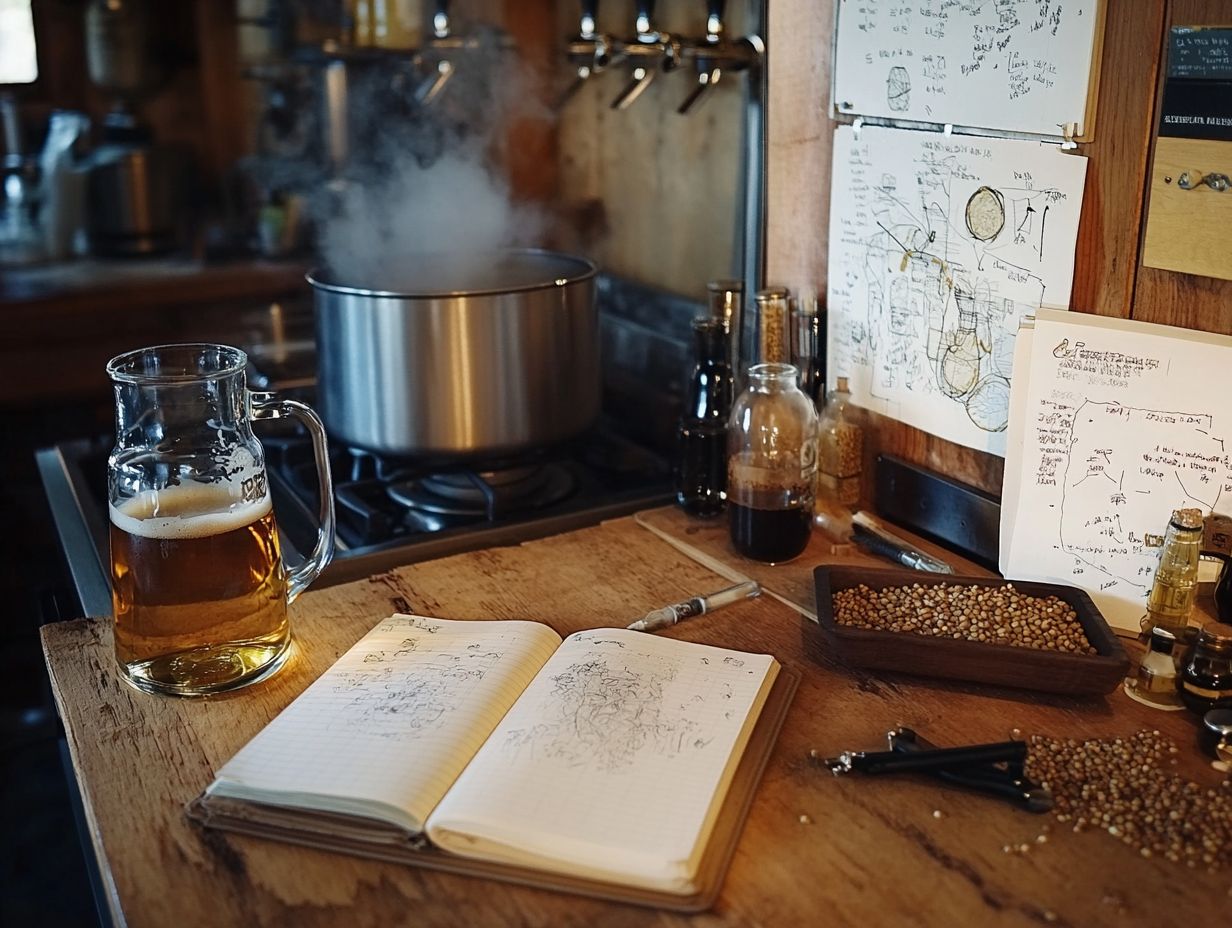
- Understand the different beer styles and how they are categorized to help guide your recipe development.
- Consider factors such as flavor preferences, ingredient availability, and brewing equipment when choosing your preferred beer style.
- Document your recipe and continue to refine and improve it over time by experimenting with different ingredients and brewing techniques.
Understanding the Different Beer Styles
Understanding the various beer styles is essential for both novice and seasoned homebrewers eager to master the art of brewing and beer design.
Craft beer culture has exploded in recent years. This has introduced a wide range of beer styles, each boasting unique characteristics and brewing processes that shape their flavor profiles. Whether you re drawn to the bold and hoppy nature of IPAs or the rich, malty allure of stouts, each style presents a distinctive experience that tantalizes the senses.
By looking into these styles, you can refine your brewing techniques and craft exceptional beer recipes tailored to your own tastes, considering factors like the initial density of the beer before fermentation and fermentation schedule.
What Are the Main Beer Styles?
The main beer styles you ll encounter include IPAs, Hefeweizens, and Oktoberfests, each offering a distinct flavor profile and a rich history within the brewing craft.
Take IPAs, for example; they re celebrated for their bold hop character, which can range from vibrant citrus and fruity notes to earthy pine and resinous undertones. This diversity showcases the innovative spirit of brewers who love to experiment with various hop varieties.
Let s take a closer look at Hefeweizens next. Hefeweizens present a cloudier appearance and delight the palate with tantalizing hints of banana and clove, a result of the specific yeasts employed during fermentation.
Oktoberfests, meanwhile, embrace a robust malt backbone, often delivering toasty and caramel notes that beautifully evoke the cozy essence of autumn.
Each of these styles boasts distinct ingredients, featuring particular malt varieties and hop varieties that not only define their unique flavors but also reflect the regional brewing traditions from which they originate.
How Are Beer Styles Categorized?
Beer styles are categorized based on a variety of factors, including bitterness levels, carbonation levels, and unique brewing methods. This classification system allows you, as a homebrewer, to identify and experiment with a plethora of different recipes.
These criteria also include flavor profiles such as fruity, malty, or hoppy notes and alcohol content, which can range widely from light session beers to rich, high-alcohol brews, reflecting the brewing efficiency achieved. By understanding these distinctions, you enable yourself to make informed adjustments to your recipes, tailoring both ingredients and techniques to achieve your desired outcomes. For instance, recognizing how varying fermentation temperatures influence flavor can help you create a more refined product.
When you grasp these classifications, you cultivate a deeper connection to the art of brewing, ultimately enhancing your chances of success in crafting the perfect beer.
Choosing Your Preferred Beer Style
Choosing your favorite beer style is an exciting step in your homebrewing journey. It allows you to tailor the experience to match your unique tastes and preferences, ensuring a satisfying homebrewing setup.
With a myriad of options at your fingertips, from the bold, hop-centric IPAs to the rich, malty stouts, grasping what truly delights your palate will steer your brewing decisions.
Consider key factors such as flavor profiles, alcohol content, and brewing methods, as they will significantly impact your final selection and brewing efficiency. Joining the homebrew community offers valuable insights and recommendations, assisting you in refining your brewing endeavors and uncovering new favorites along the way.
What Are the Factors to Consider When Choosing a Beer Style?
When selecting a beer style, there are several factors you should take into account, including your desired flavor profile, the available ingredients, the batch size you plan to brew, and the brewing methods you will use. Understanding these elements is essential for creating a brew that not only meets your expectations but also shines in taste and quality.
For example, if you’re leaning toward a hoppy IPA, you might want to focus on specific hops that impart those delightful citrus or pine notes that define the style. Being aware of how different malts influence sweetness and color can help you refine your brew s character.
Don’t shy away from experimenting with ingredient ratios; making small adjustments can lead to extraordinary flavor developments and better brewing efficiency.
Keep the fermentation process in mind, as it plays a pivotal role in the process where yeast turns sugars into alcohol, allowing you to further customize and enhance your final product.
Understanding the Basic Ingredients of Beer
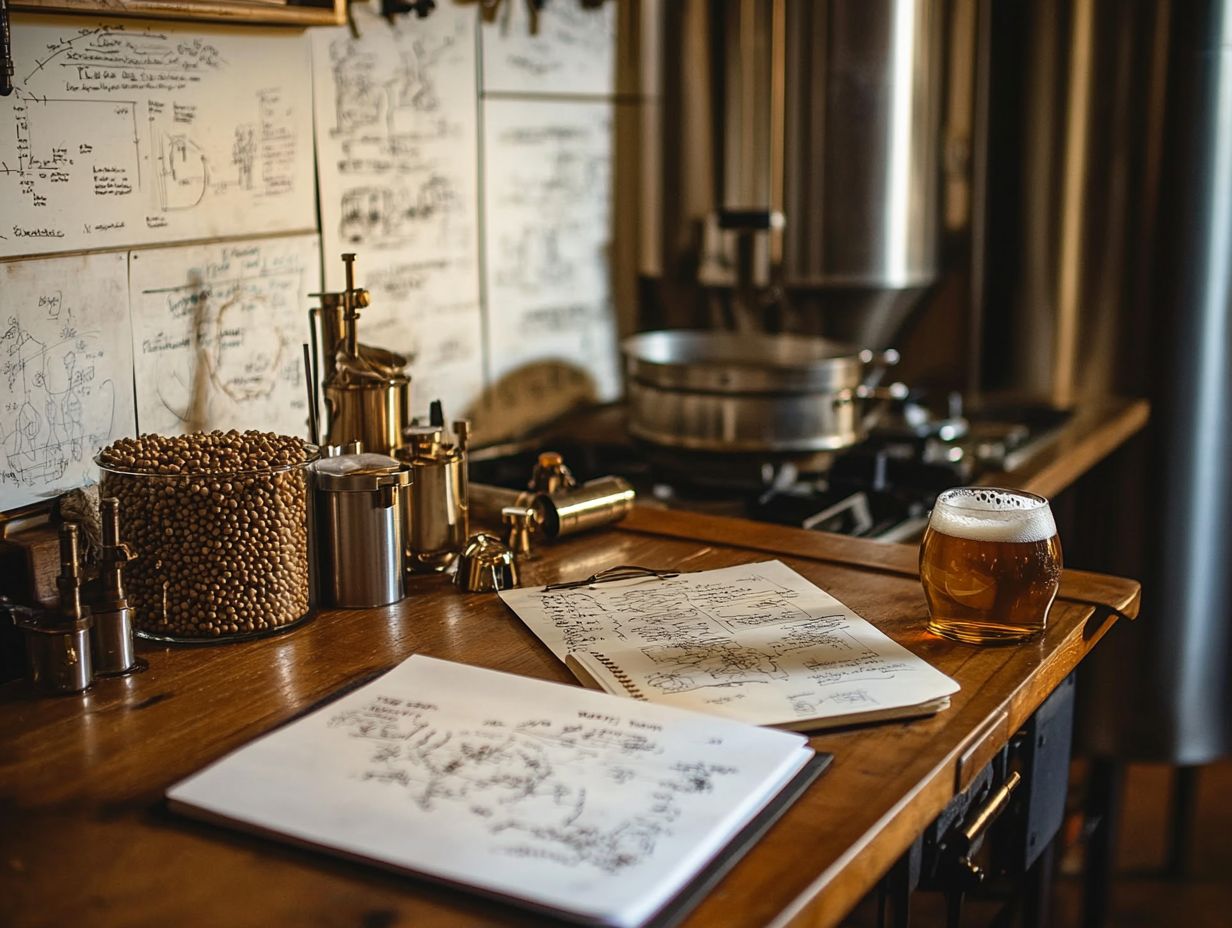
Grasping the basic ingredients of beer is essential for any aspiring homebrewer, as these elements will profoundly impact both the brewing process and the final outcome.
The four primary ingredients malt, hops, yeast, and water each serve a distinct purpose in creating a wide array of beer styles.
Different malt varieties, such as pale malt, chocolate malt, and roasted barley, introduce a spectrum of flavors and colors, while hop varieties like Cascade hops, noble hops, and German hops impart enticing aromas and a balanced bitterness.
Yeast, including options like California Ale Yeast, plays a pivotal role in fermentation, converting sugars into alcohol and rich, complex flavors.
What Are the Four Main Ingredients of Beer?
The four essential ingredients of beer malt, hops, yeast, and water each play a vital role in the brewing process and contribute uniquely to the beer’s overall flavor.
Malt serves as the foundation of beer’s flavor profile and comes in various types. You ll encounter pale malts that add sweetness and body, as well as roasted malts that deliver deep, rich flavors and colors that allure the senses.
Hops, on the other hand, are celebrated for their aromatic properties. They vary from bittering varieties that balance sweetness to aromatic types that infuse floral or citrus notes into the brew.
Yeast strains are critical; they not only ferment sugars but also generate distinctive flavors. Whether you opt for ale or lager yeasts, each brings unique taste characteristics to the table.
Finally, don t underestimate the impact of water quality. Its mineral content can significantly affect mouthfeel and flavor, illustrating how the interplay of these ingredients creates a remarkable range of beer styles, each with its distinctive profile waiting to be explored.
Creating Your Own Beer Recipe
Crafting your own beer recipe is an exhilarating adventure that blends creativity with the precision of science. This journey gives you the freedom to experiment with various brewing techniques and ingredients to create a distinctive craft beer. Balancing your malt bill and understanding your brewing calculations will help perfect your recipe.
Your journey starts by defining your ideal beer style and flavor profile. Next, you will make careful calculations and thoughtful adjustments to your ingredients list.
By mastering the brewing process, including fermentation temperature and timing, you can keep the yeast in prime condition and active throughout the fermentation period.
Using brewing software simplifies your recipe development and elevates your homebrewing experience to new heights. It ensures your fermentation schedule and brewing goals are meticulously planned.
What Are the Steps to Developing a Beer Recipe?
Developing your own beer recipe involves several key steps that will ensure your final product achieves the flavor profile and brewing goals you desire.
Selecting the right ingredients is absolutely crucial. Different malts, hops, and yeasts each bring their own unique flavors and aromas to the table, forming the basis of your ingredients list.
Once you’ve chosen your ingredients, the brewing method becomes paramount. Whether you opt for all-grain, partial mash, or extract brewing, each technique introduces its own nuances to your brew.
After the brewing process kicks off, don t underestimate the power of taste testing and evaluating the flavor contribution. This is your opportunity to assess the flavors, aromas, and overall balance of your beer.
Through attentive tasting, you can make necessary adjustments, like altering hop schedules or tweaking fermentation temperatures. These changes can significantly enhance your brewing process and lead to a truly exceptional final product.
Experimenting with Different Ingredients and Techniques
Experimenting with various ingredients and brewing techniques is at the heart of homebrewing. It gives you the power to craft unique flavors and innovative beer styles. You have the opportunity to explore an array of malt varieties, hop types, and yeast strains, uncovering new flavor profiles that will invigorate your palate.
These practices can be enhanced by utilizing original gravity measurements, which indicate the initial sugar content of your brew. Making precise recipe adjustments can help perfect your beer.
Techniques like dry hopping and adjusting fermentation temperatures can elevate your beer’s characteristics even further. This creative exploration can lead you to develop personal signature recipes that truly stand out within the homebrew community.
Using brew-in-a-bag methods simplifies the brewing process, making it more accessible for new brewers.
What Are Some Common Ingredients Used in Beer Recipes?
When crafting your own beer, you’ll find that certain key ingredients are essential to the recipe: various malt varieties, hop types, yeast strains, and, of course, water. Each of these components plays a vital role in the brewing process.
Understanding the ingredients list and how each one contributes to the final product is crucial. Malt is the backbone of your beer. Different types, such as pale malt, Munich, and roasted malts, contribute unique flavors that can range from sweet and biscuity to rich and chocolatey.
Hops, with their aromatic qualities and bitterness, balance the sweetness of the malt while introducing a spectrum of floral, citrus, or earthy notes, depending on the variety you choose. Some popular hops to consider include Cascade, Saaz, and Simcoe, along with other varieties like German hops and noble hops.
Equally important is the yeast strain you select. Yeast ferments the sugars extracted from the malts into alcohol and carbon dioxide, while also shaping the overall flavor profile. With options like Ale and Lager yeasts, each brings its own distinct characteristics to the brew.
It’s crucial to monitor yeast health throughout the fermentation process to ensure optimal performance and flavor. Don t overlook the role of water, either. Its mineral content can significantly influence the beer’s body and mouthfeel.
Together, these fundamental ingredients work in harmony to create a wide array of styles and flavors, inviting you to explore the art of brewing like a true connoisseur. Using brewing software helps you manage these variables more efficiently, optimizing your brewing goals.
How Can You Incorporate Unique Flavors into Your Beer?
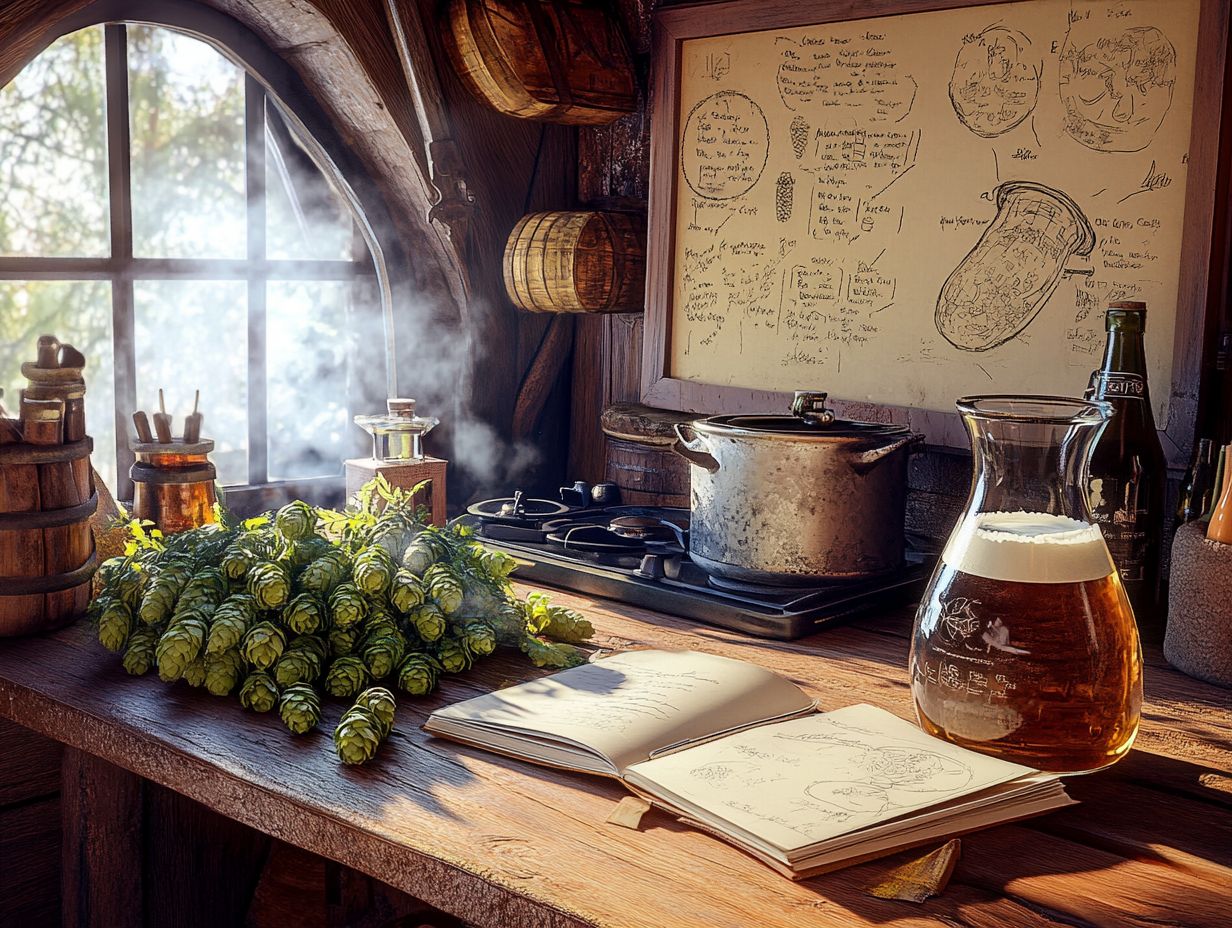
Incorporating unique flavors into your beer can truly elevate your homebrew experience. This allows you to experiment with unconventional ingredients and innovative brewing techniques. This creative approach serves as your canvas for innovation, encouraging you to explore diverse taste profiles that intrigue and delight the palate.
Consider starting with a SMaSH (a type of beer recipe that uses one malt and one hop to highlight those flavors) to simplify the process and better understand each ingredient’s flavor contribution.
Imagine using specialty grains that introduce unexpected sweetness or nuttiness. You can also experiment with various hop strains to uncover floral or fruity notes. The world of brewing is vast and inviting, full of possibilities waiting for you to discover.
Adding adjuncts like fruits, spices, or even coffee can further expand your flavor spectrum. But remember, achieving a harmonious balance is key. You want to avoid overpowering the base brew while still enhancing its character.
Using specific brew techniques tailored to your beer style can help in achieving this balance. Mastering this delicate equilibrium ensures that all these elements blend seamlessly, creating a cohesive beer profile that keeps your drinkers coming back for more.
Embrace the art of brewing, and let your creativity flow into each batch. Using brewing history as inspiration can also add depth to your creations, connecting tradition with innovation.
Documenting and Refining Your Recipe
Documenting and refining your beer recipe is essential for any serious homebrewer. It enables you to meticulously track your brewing process and make informed adjustments for future batches.
Utilizing tools like a homebrewing journal or brewing software can significantly streamline this documentation process. Keeping a detailed record is your secret weapon for mastering the craft!
By maintaining a homebrewing journal, you can capture every detail, from ingredient selection to brewing calculations and fermentation schedule. This thoughtful record-keeping allows you to analyze what worked and what didn t.
This paves the way for successful recipe modifications that will elevate your brewing skills with each brew. Keeping track of your batch size and brewing efficiency can also help in making accurate adjustments.
Why Is It Important to Document Your Recipe?
Documenting your beer recipe is vital as it preserves the distinctive elements of your brewing process. It allows you to replicate those successful batches when the moment calls for it. This is particularly important if you’re aiming to create a consistent craft beer that resonates with your audience.
By keeping meticulous records, you can ensure greater consistency in your creations. This makes it simpler to achieve that perfect flavor profile every single time. Detailed notes provide you with the opportunity to analyze each batch’s outcomes.
This offers valuable insights into what worked brilliantly and what may require a little fine-tuning. This introspection is essential for your growth and improvement in the craft.
Sharing successful recipes can cultivate a sense of community among fellow brewers. This fosters an environment where knowledge exchange and collaboration thrive, ultimately elevating everyone’s brewing skills to new heights.
How Can You Improve and Refine Your Recipe Over Time?
Improving and refining your beer recipe is an art that requires a blend of experimentation, feedback, and consistent practice. By engaging with fellow homebrewers and sharing your creations, you open the door to valuable insights that can greatly enhance your brewing skills.
Gathering feedback from tasters is essential; their impressions may uncover unexpected flavors or aromas that you might have overlooked. Making incremental adjustments in your ingredients or methods enables a more controlled approach to crafting your ideal brew.
Carefully monitoring the fermentation temperature can also make a significant difference in flavor and aroma development. Don t wait to explore new brewing techniques these adventures can lead to delightful discoveries!
Above all, keep in mind that patience and practice are your steadfast allies in this craft. Each batch successful or otherwise brings you one step closer to perfecting your recipe.
Troubleshooting Common Issues in Beer Recipe Development
Troubleshooting common issues in beer recipe development is crucial for any homebrewer aspiring to refine their craft and boost brewing efficiency. Throughout the brewing process, various challenges may emerge, ranging from fermentation troubles to unexpected off-flavors in the final product. Keeping an eye on carbonation levels is essential, as it can impact the overall drinking experience.
By grasping these issues, you enable yourself to make timely adjustments and modifications to your recipes. This paves the way for a smoother brewing experience and more successful beer outcomes.
What Are Some Common Problems Faced During Recipe Development?
During your journey of beer recipe development, you may encounter challenges such as fermentation issues, off-flavors, and inconsistencies in brewing techniques. These hurdles can significantly impede the quality of your final product. Participating in the Beer Judge Certification Program can provide you with specialized knowledge to overcome these obstacles more effectively.
These challenges often arise from various factors, including temperature fluctuations, inadequate sanitation practices, or unbalanced ingredient ratios. For example, the temperature at which you add yeast can lead to sluggish or stalled fermentation. Undesirable off-flavors might stem from contaminating bacteria or overly aggressive hops.
It’s essential to recognize that frequent changes in your brewing methods can result in inconsistency, ultimately affecting the taste and aroma of your brew. Learning about beer styles can help you understand traditional profiles and adjust accordingly.
By gaining a deeper understanding of the brewing process, you can effectively address these issues and enrich your brewing experience. With this knowledge in hand, you re ready to craft homebrews that truly wow your friends and family!
How Can You Fix These Issues and Improve Your Recipe?
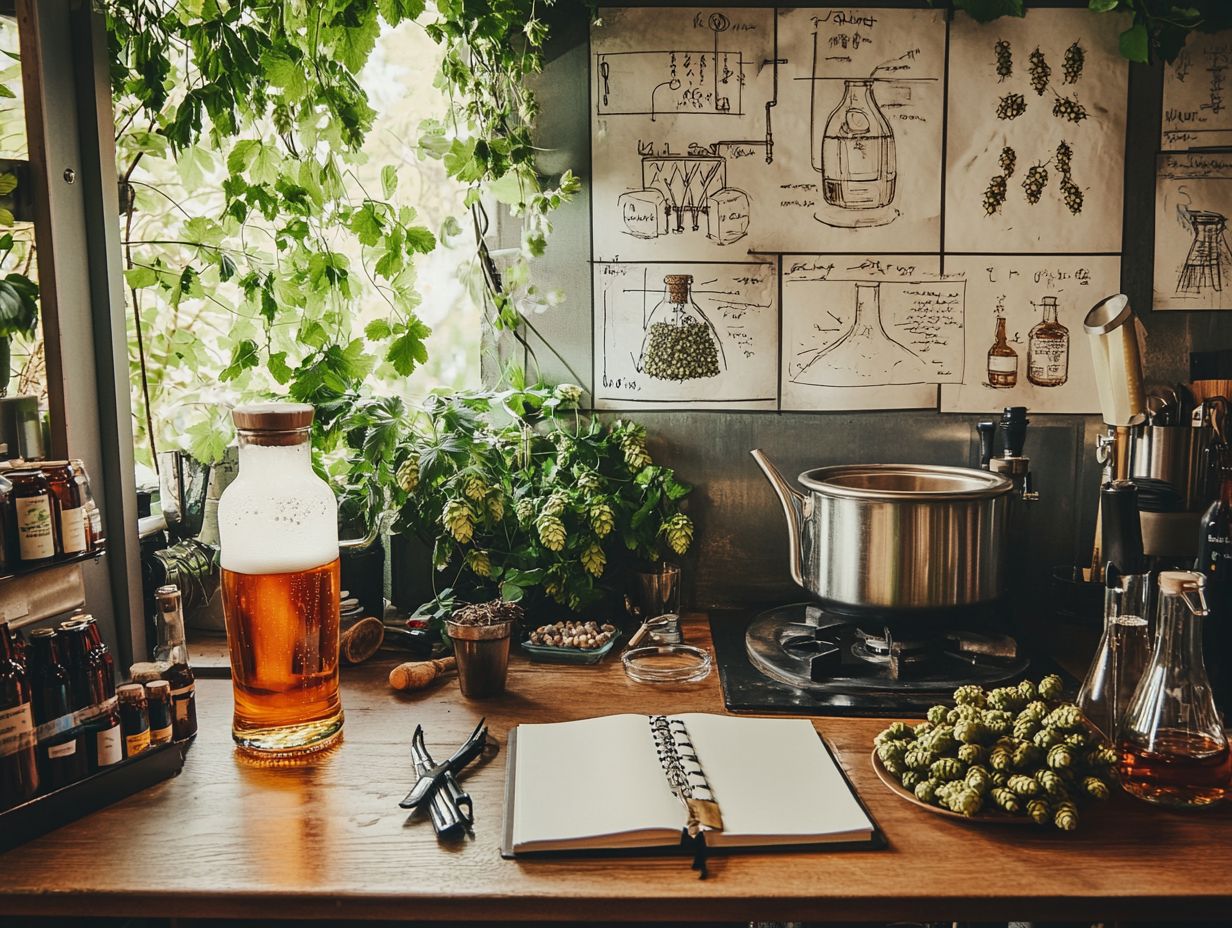
Fixing issues in your beer recipe and enhancing it for future batches calls for a blend of troubleshooting, adjustments, and a dash of adventurous experimentation. Using a beer kit can simplify this process, providing a controlled environment for testing new ideas.
Begin by meticulously examining each step of your brewing process, from the selection of ingredients to the fermentation timeline. If a particular batch doesn t quite hit the mark, reflect on how changing ingredient ratios might influence flavor or clarity. You might find it advantageous to tweak fermentation temperatures lowering them can often bring out delicate flavor notes, while raising them could ramp up yeast activity. Understanding the malt bill and its impact on the final flavor is also crucial.
Keeping a detailed record of each brew allows you to look back on both triumphs and missteps, crafting a solid framework for improvement. By identifying trends and patterns, you ll sharpen your techniques and, over time, create a beer that aligns ever more closely with your vision. Utilizing platforms like Brew Cabin can provide additional resources and community support.
Frequently Asked Questions
What is the first step in developing my own beer design?
The first step is to research different beer styles and take notes on the ingredients and brewing processes involved. This will give you a solid foundation to start experimenting with your own recipe. Understanding brewing history can provide valuable insights into traditional methods and ingredients.
Do I need any special equipment to develop my own beer recipe style?
You will need basic brewing equipment such as a fermenter, airlock, thermometer, and hydrometer. Depending on the recipe style you want to develop, you may also need additional equipment such as a mash tun or wort chiller. Some advanced brewers might also use brewing software to track and optimize their processes.
Brewing beer is an art that requires careful consideration of ingredients, technique, and consistency. To get started, check out this guide on how to create your own signature beer recipe. Here are some essential tips to help you master your beer recipes!
How do I determine the right balance of ingredients for my beer recipe style?
It is important to understand the flavor profiles of different ingredients and how they work together. Experiment with different ratios. Take detailed notes to find the perfect balance for your desired beer style. Monitoring the bitterness level the sharp flavor that hops contribute and carbonation level, which indicates the fizziness of the beer, will also help achieve the ideal flavor profile.
Can I use unconventional ingredients in my beer recipes?
Yes, you can use unconventional ingredients such as fruit, spices, or herbs to add unique flavors to your beer recipes. Don t hesitate to experiment! Using unique ingredients can lead to extraordinary and unexpected flavors in your beer. Just make sure to research the best way to incorporate these ingredients into your brewing process, considering your ingredients list and brewing techniques.
What is the importance of water in developing a beer recipe style?
Water plays a crucial role in the final flavor profile of your beer. Different beer styles have different water requirements. It is important to understand your water source and how to adjust it to fit your desired beer style. For example, brewing an IPA might require different water chemistry adjustments compared to a Hefeweizen or Oktoberfest.
How can I ensure consistency in my beer recipe style?
Consistency is key in brewing. Keep detailed notes of each batch and make recipe adjustments as needed. Use the same ingredients, including malt varieties like Pale Malt or Chocolate Malt, and brewing techniques each time to achieve consistent results. You might also want to consider using brewing software like BeerSmith to track your fermentation schedule, original gravity, and other brewing calculations.
Engaging with the homebrew community and participating in programs like the Beer Judge Certification Program can also help you refine your brewing methods and achieve consistency.
Share your own recipes or experiences in brewing with us!

